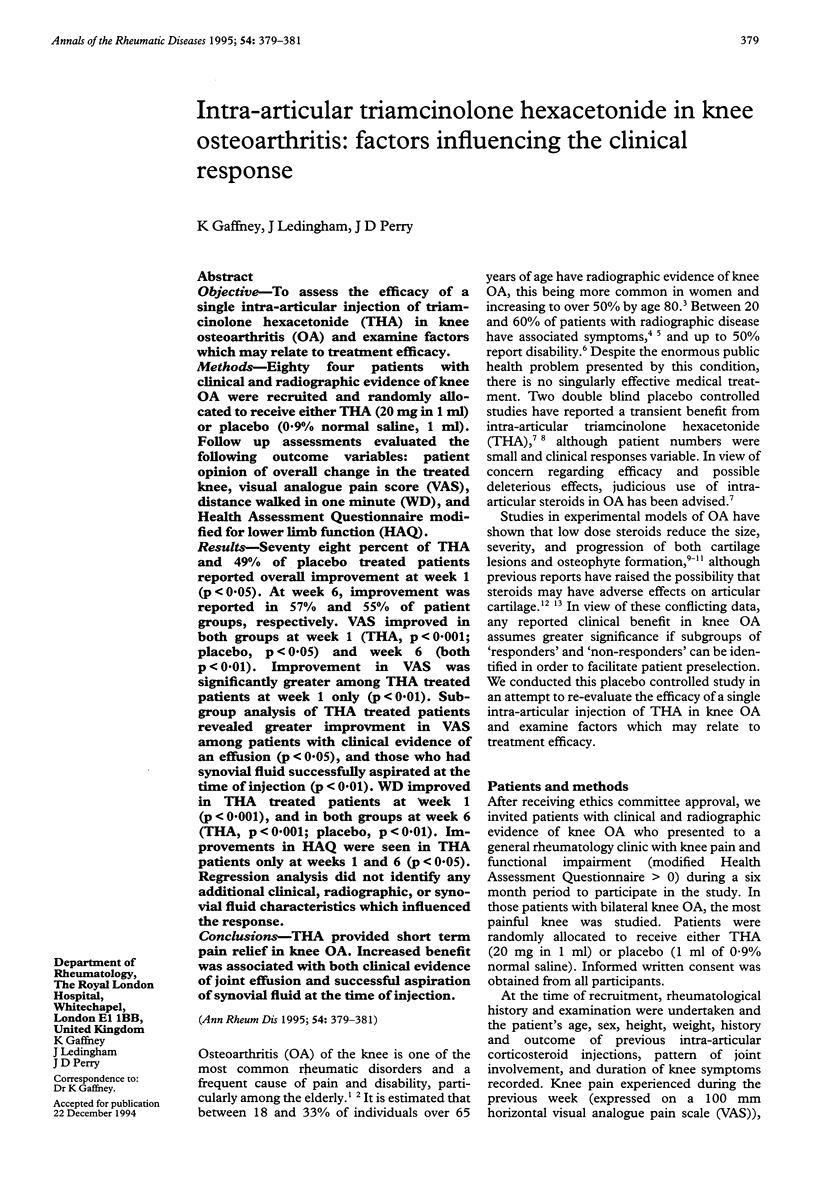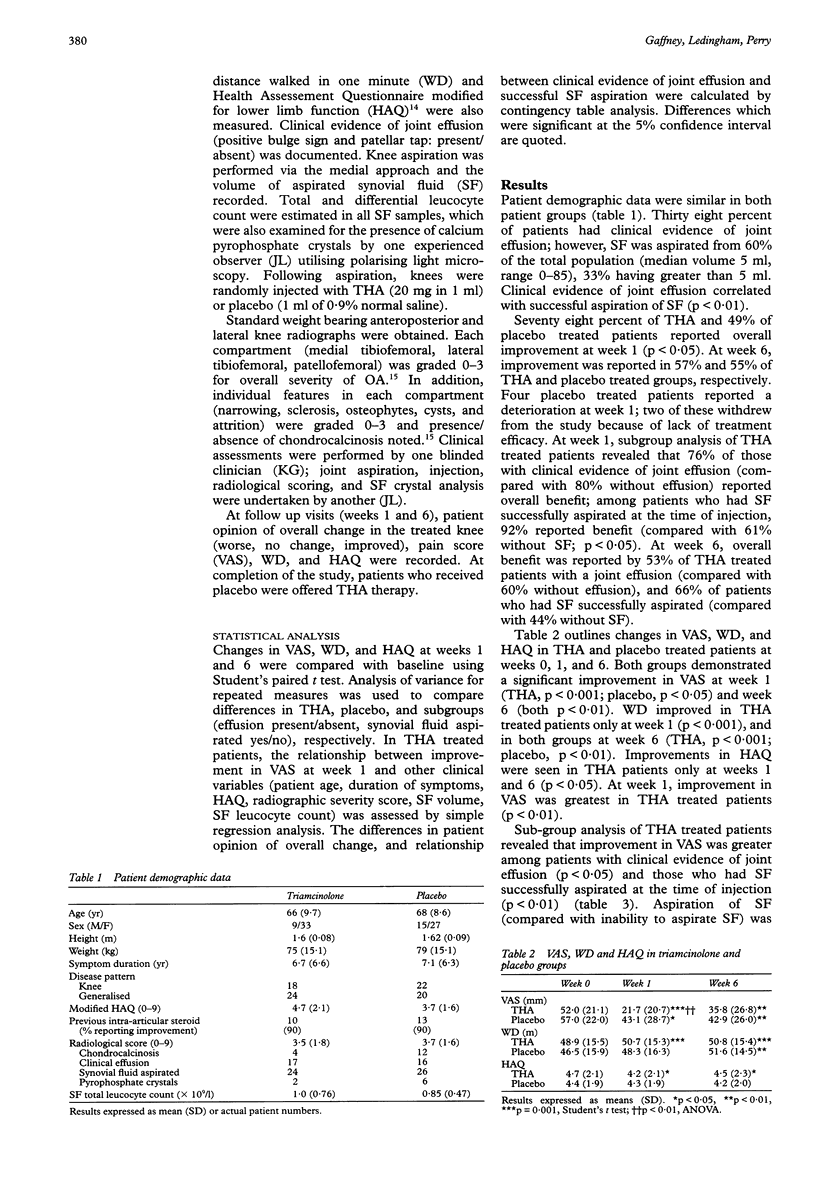Abstract
OBJECTIVE--To assess the efficacy of a single intra-articular injection of triamcinolone hexacetonide (THA) in knee osteoarthritis (OA) and examine factors which may relate to treatment efficacy. METHODS--Eighty four patients with clinical and radiographic evidence of knee OA were recruited and randomly allocated to receive either THA (20 mg in 1 ml) or placebo (0.9% normal saline, 1 ml). Follow up assessments evaluated the following outcome variables: patient opinion of overall change in the treated knee, visual analogue pain score (VAS), distance walked in one minute (WD), and Health Assessment Questionnaire modified for lower limb function (HAQ). RESULTS--Seventy eight percent of THA and 49% of placebo treated patients reported overall improvement at week 1 (p < 0.05). At week 6, improvement was reported in 57% and 55% of patient groups, respectively. VAS improved in both groups at week 1 (THA, p < 0.001; placebo, p < 0.05) and week 6 (both p < 0.01). Improvement in VAS was significantly greater among THA treated patients at week 1 only (p < 0.01). Subgroup analysis of THA treated patients revealed greater improvement in VAS among patients with clinical evidence of an effusion (p < 0.05), and those who had synovial fluid successfully aspirated at the time of injection (p < 0.01). WD improved in THA treated patients at week 1 (p < 0.001), and in both groups at week 6 (THA, p < 0.001; placebo, p < 0.01). Improvements in HAQ were seen in THA patients only at weeks 1 and 6 (p < 0.05). Regression analysis did not identify any additional clinical, radiographic, or synovial fluid characteristics which influenced the response. CONCLUSIONS--THA provided short term pain relief in knee OA. Increased benefit was associated with both clinical evidence of joint effusion and successful aspiration of synovial fluid at the time of injection.
Full text
PDF


Selected References
These references are in PubMed. This may not be the complete list of references from this article.
- Davis M. A., Ettinger W. H., Neuhaus J. M., Mallon K. P. Knee osteoarthritis and physical functioning: evidence from the NHANES I Epidemiologic Followup Study. J Rheumatol. 1991 Apr;18(4):591–598. [PubMed] [Google Scholar]
- Dieppe P. A. Are intra-articular steroid injections useful for the treatment of the osteoarthritis joint? Br J Rheumatol. 1991 Jun;30(3):199–199. doi: 10.1093/rheumatology/30.3.199. [DOI] [PubMed] [Google Scholar]
- Dieppe P. A., Sathapatayavongs B., Jones H. E., Bacon P. A., Ring E. F. Intra-articular steroids in osteoarthritis. Rheumatol Rehabil. 1980 Nov;19(4):212–217. doi: 10.1093/rheumatology/19.4.212. [DOI] [PubMed] [Google Scholar]
- Felson D. T., Naimark A., Anderson J., Kazis L., Castelli W., Meenan R. F. The prevalence of knee osteoarthritis in the elderly. The Framingham Osteoarthritis Study. Arthritis Rheum. 1987 Aug;30(8):914–918. doi: 10.1002/art.1780300811. [DOI] [PubMed] [Google Scholar]
- Friedman D. M., Moore M. E. The efficacy of intraarticular steroids in osteoarthritis: a double-blind study. J Rheumatol. 1980 Nov-Dec;7(6):850–856. [PubMed] [Google Scholar]
- Hadler N. M. Osteoarthritis as a public health problem. Clin Rheum Dis. 1985 Aug;11(2):175–185. [PubMed] [Google Scholar]
- Hart D. J., Spector T. D., Brown P., Wilson P., Doyle D. V., Silman A. J. Clinical signs of early osteoarthritis: reproducibility and relation to x ray changes in 541 women in the general population. Ann Rheum Dis. 1991 Jul;50(7):467–470. doi: 10.1136/ard.50.7.467. [DOI] [PMC free article] [PubMed] [Google Scholar]
- Jones A., Regan M., Ledingham J., Pattrick M., Manhire A., Doherty M. Importance of placement of intra-articular steroid injections. BMJ. 1993 Nov 20;307(6915):1329–1330. doi: 10.1136/bmj.307.6915.1329. [DOI] [PMC free article] [PubMed] [Google Scholar]
- Ledingham J., Regan M., Jones A., Doherty M. Radiographic patterns and associations of osteoarthritis of the knee in patients referred to hospital. Ann Rheum Dis. 1993 Jul;52(7):520–526. doi: 10.1136/ard.52.7.520. [DOI] [PMC free article] [PubMed] [Google Scholar]
- McAlindon T. E., Cooper C., Kirwan J. R., Dieppe P. A. Determinants of disability in osteoarthritis of the knee. Ann Rheum Dis. 1993 Apr;52(4):258–262. doi: 10.1136/ard.52.4.258. [DOI] [PMC free article] [PubMed] [Google Scholar]
- Moskowitz R. W., Davis W., Sammarco J., Mast W., Chase S. W. Experimentally induced corticosteroid arthropathy. Arthritis Rheum. 1970 May-Jun;13(3):236–243. doi: 10.1002/art.1780130304. [DOI] [PubMed] [Google Scholar]
- Pelletier J. P., Martel-Pelletier J. Protective effects of corticosteroids on cartilage lesions and osteophyte formation in the Pond-Nuki dog model of osteoarthritis. Arthritis Rheum. 1989 Feb;32(2):181–193. doi: 10.1002/anr.1780320211. [DOI] [PubMed] [Google Scholar]
- Pelletier J. P., Mineau F., Raynauld J. P., Woessner J. F., Jr, Gunja-Smith Z., Martel-Pelletier J. Intraarticular injections with methylprednisolone acetate reduce osteoarthritic lesions in parallel with chondrocyte stromelysin synthesis in experimental osteoarthritis. Arthritis Rheum. 1994 Mar;37(3):414–423. doi: 10.1002/art.1780370316. [DOI] [PubMed] [Google Scholar]
- Williams J. M., Brandt K. D. Triamcinolone hexacetonide protects against fibrillation and osteophyte formation following chemically induced articular cartilage damage. Arthritis Rheum. 1985 Nov;28(11):1267–1274. doi: 10.1002/art.1780281111. [DOI] [PubMed] [Google Scholar]
- van Saase J. L., van Romunde L. K., Cats A., Vandenbroucke J. P., Valkenburg H. A. Epidemiology of osteoarthritis: Zoetermeer survey. Comparison of radiological osteoarthritis in a Dutch population with that in 10 other populations. Ann Rheum Dis. 1989 Apr;48(4):271–280. doi: 10.1136/ard.48.4.271. [DOI] [PMC free article] [PubMed] [Google Scholar]


